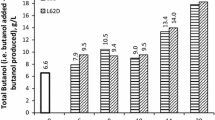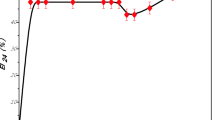Abstract
It has been shown that the Rhodococcus erythropolis sH-5 strain can produce surfactants associated and not associated with the cell wall. Their content depends on medium composition, the nature of the carbon source, and oxygen supply. The highest biosurfactant (bioSF) yield is achieved by growing R. erythropolis sH-5 in medium with 2% kerosene at neutral pH. It has been found that the bioSF yield and emulsification index for various hydrocarbons depend on the kind of the nitrogen source used by the bacterium, increasing with replacement of KNO3 by NaNO3. The yields of biomass and bioSF in R. erythropolis depend on growth temperatures (max at 30°C) but not on water quality (bidistillate, catholyte, or anolyte). It has been found that sH-5 produces more cell-associated bioSF than extracellular species.
Similar content being viewed by others
References
Desai, J.D. and Banat, I.M., Microbiol. Mol. Biol. Rev., 1997, vol. 61, no. 1, pp. 47–64.
Abramzon, A.A., Zaichenko, L.P., and Raingol’d, S.I., Poverkhnostono-aktivnye veshchestva. Sintez, analiz, primenenie (Surfactants: Synthesis, Analysis, and Application), Leningrad: Khimiya, 1988.
Gogotov, I.N., Belonozhkin, S.V., Khodakov, R.S., and Shkidchenko, A.N., Biosurfaktanty: produtsenty, svoistva i prakticheskoe ispol’zovanie. Materialy 3-i Mezhd. konf. “Mezhdunarodnoe sotrudnichestvo v biotekhnologii: ozhidaniya i real’nost’” (Biosurfactants: Producers, Properties, and Application in Practice. 3rd Int. Conf. International Cooperation in Biotechnology: Expectations and Reality), Pushchino: ITs “Bioresursy i ekologiya”, 2006, pp. 104–111.
Rosenberg, E., CRS Crit. Rev. Biotechnol., 1986, vol. 3, pp. 109–132.
Cooper, D.C. and Goldenger, B.G., Appl. Environ. Microbiol., 1987, vol. 53, no. 2, pp. 224–229.
Bruskov, V.I., Masalimov, Zh.K., and Chernikov, A.V., Dokl. Akad. Nauk, 2002, vol. 384, no. 6, pp. 821–824 [Dokl. (Engl. Transl.), vol. 384, no. 6, pp. 181–184].
Miroshnikov, A.I., Masalimov, Zh.K., and Bruskov, V.I., Molek. Biofizika, 2004, vol. 49, no. 1, pp. 32–37.
Pirog, T.P., Voloshina, I.N., Ignatenko, S.V., and Vil’danova-Martsishina, R.I., Biotekhnologiya, 2003, no. 6, pp. 27–36.
Rapp, P. and Gabriel-Jurgens, L.H., Microbiology, 2003, vol. 149, no. 8, pp. 2879–2890.
Prilutskii, V.I. and Bakhir, V.M., Elektrokhimicheski aktivirovannaya voda: anomal’nye svoistva, mekhanizm biologicheskogo deistviya (Electrochemically Activated Water: Abnormal Properties and the Mechanism of Biological Action), Moscow: VNII Med. Tekhn., 1997.
Petrushanko, I.Yu. and Lobyshev, V.I., Biofizika, 2001, vol. 46, no. 3, pp. 389–401.
Kloss, A.I., Dokl. Akad. Nauk SSSR, 1988, vol. 303, no. 6, pp. 1403–1407.
Rapp, P., Bock, H., Wray, V., and Wagner, F., J. Gen. Microbiol., 1979, vol. 115, pp. 491–503.
Shkidchenko, A.N., Petrikevich, S.B., and Kobzev, E.N., Biotekhnologiya, 2004, no. 3, pp. 70–74.
Knetting, E. and Zajic, J.E., Biotech. Bioeng., 1972, vol. 14, no. 3, pp. 379–390.
Author information
Authors and Affiliations
Corresponding author
Additional information
Original Russian Text © I.N. Gogotov, R.S. Khodakov, 2008, published in Prikladnaya Biokhimiya i Mikrobiologiya, 2008, Vol. 44, No. 2, pp. 207–212.
Rights and permissions
About this article
Cite this article
Gogotov, I.N., Khodakov, R.S. Surfactant production by the Rhodococcus erythropolis sH-5 bacterium grown on various carbon sources. Appl Biochem Microbiol 44, 186–191 (2008). https://doi.org/10.1134/S0003683808020105
Received:
Published:
Issue Date:
DOI: https://doi.org/10.1134/S0003683808020105




